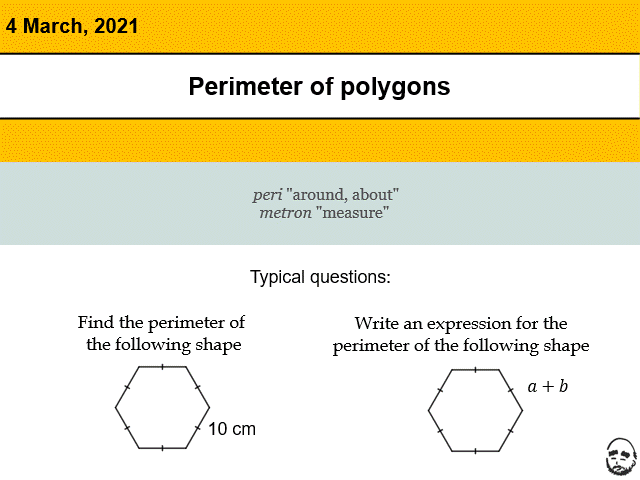Download the PowerPoint here | Download the worksheet here (not technically needed, just the PPT questions in a printer friendly format) | Download the plotting and measuring worksheet.

One of the best MathsConf sessions I’ve been to, and one that I come back to again and again is Jo Morgan’s Indices in Depth (Watch a recorded version here). It really stuck with me because of something she said.
I’m paraphrasing, but Jo said that she used to cover all of the index laws in one lesson, but she now realises how that wasn’t good.
When I watched that presentation, I was also covering index laws in one lesson. By doing that we rob ourselves of the opportunity to develop mathematical thinking. We rob ourselves of doing interesting questions or delving into specifics and really covering things in the detail and sophistication that we should.
Anyway, I normally cover perimeter in one lesson. Add up the sides!
But it in trying to make some better slides I realised how much you can do with it. Change of units! Being explicit about what the different marks on the lines mean?

So this is an attempt to address all of that.
There’s example problem pairs and exercises for:
- Regular perimeter, including the notation
- Finding a side, given the perimeter
- Finding missing sides and compound shapes
- Measuring the perimeter (by plotting coordinates and using a ruler to measure the perimeter)
- Using different units
- Some algebraic stuff.

also a lovely discussion picture

You could probably easily do 3 lessons on this. Using perimeter to build mathematical thinking, rather than just teaching the content. The content is a conduit.
One of the best ways to do this is I’ve seen is Mr Draper’s lessons here. I’d highly recommend you checking that out. Especially these questions, which I think are gorgeous.

So that’s a good 5 lessons you could probably do with perimeter, not including the old area/perimeter investigation when you try and keep one constant and change the other.
One lesson I’d been using. Think of all the lost opportunity.
